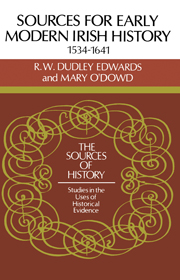Book contents
- Frontmatter
- Contents
- Acknowledgements
- Abbreviations
- Introduction
- 1 IRISH CIVIL CENTRAL ADMINISTRATION
- 2 IRISH CIVIL LOCAL ADMINISTRATION
- 3 ENGLISH AND OTHER CENTRAL ADMINISTRATIONS AND IRELAND
- 4 IRISH ECCLESIASTICAL ADMINISTRATION
- 5 CONTEMPORARY ACCOUNTS AND DESCRIPTIONS
- 6 MAPS AND DRAWINGS
- 7 ARCHIVAL COLLECTIONS
- 8 HISTORIOGRAPHY
- Index
1 - IRISH CIVIL CENTRAL ADMINISTRATION
Published online by Cambridge University Press: 08 January 2010
- Frontmatter
- Contents
- Acknowledgements
- Abbreviations
- Introduction
- 1 IRISH CIVIL CENTRAL ADMINISTRATION
- 2 IRISH CIVIL LOCAL ADMINISTRATION
- 3 ENGLISH AND OTHER CENTRAL ADMINISTRATIONS AND IRELAND
- 4 IRISH ECCLESIASTICAL ADMINISTRATION
- 5 CONTEMPORARY ACCOUNTS AND DESCRIPTIONS
- 6 MAPS AND DRAWINGS
- 7 ARCHIVAL COLLECTIONS
- 8 HISTORIOGRAPHY
- Index
Summary
The capital city of Ireland in the early modern period was unquestionably Dublin. It should follow that Irish civil, central administrative affairs were located at Dublin. In so far as it was the seat of the chief governor it could also be argued that Dublin was the governmental centre. The answer was not always that simple. For most of the period it was not the ecclesiastical capital. For crucial civil matters, especially after 1534, London asserted itself as the central authority. Even in times of weakness London endeavoured to reserve a right to intervene by distinguishing between the monarch's locum tenens (his lieutenant), usually resident at court, and a deputy in Ireland.
From as early as the mid thirteenth century and possibly earlier, the appointment of chancellors, treasurers and other officials functioning in connection with the chancery and the exchequer created a structure of central government. Under a dominating chief governor resident in London other office-holders might only transact routine functions. Yet it might be assumed that the tradition of a functioning chancery and exchequer was unbroken even if their location was sometimes removed temporarily out of Dublin. In times of royal strength, when the monarch's office-holders in England could function for Ireland, the central Irish civil administration might appear to be more of a local authority. On such occasions Dublin would not traverse the central assumptions of London preferring to assert its right to channel all decisions from and to the monarch. That only occasionally Dublin did assert its omnicompetence should not delude the student into uncritically accepting unqualified assertions of monarchical control for London.
- Type
- Chapter
- Information
- Sources for Modern Irish History 1534–1641 , pp. 3 - 41Publisher: Cambridge University PressPrint publication year: 1985



